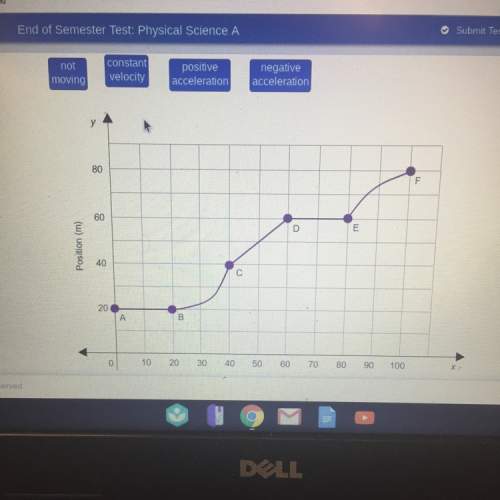
Physics, 28.09.2019 22:30 Omarrdz214
Newton's equation in (5) has an "equilibrium" solution , a constant, corresponding to a circular orbit (a) what are cı, c2 in the equilibrium solution? what is r in terms of g, m, d? (b) for a circular orbit d2tr2 /t where t is the time it takes the planet to circle the sun use this and your result from (a) to get a formula for (r3/12) that depends only on g, m, and π (kepler's 3rd law) (d) weigh the sun! that is, plug in g = 6.67 × 10-11m3kg-1sec-2, r-93 million miles, t= 1 year, and solve for m. how does this compare with the value from a reputable source? problems (7-10) are backwards problems. you are given the family of infinitely many solutions y(t) with one or more arbitrary constants. your task is to figure out the differential equation (with no arbitrary constants) that is satisfied by the given family. a good general strategy is the isolate-annihilate method: first manipulate the formula to solve for (i. e. isolate) the arbitrary constant (or one of them) in terms of t, y (and other arbitrary constants if any) second, differentiate that formula to annihilate the arbitrary constant. you now have an equation that involves t, y(t) and y'(t) in what may be a complicated way, but the arbitrary constant that you isolated is now gone if there are no remaining arbitrary constants, you're done! otherwise repeat the process to isolate and annihilate the next arbitrary constant. the end result will be an equation relating t, y(t), and as many derivatives of y(t) as the original formula had arbitrary constants. in each part of (7-10) say whether the resulting differential equation is linear or nonlinear, au- tonomous or nonautonomous, and "vertical shift invariant" (i. e. only involves derivatives of y(t) but not values) or not (7,8) for each of the following families of functions with one arbitrary constant, find the 1st order differential equation it satisfies. (a) y(t) c +et, (b) y(t) ce, (c) y(t)et, (d) y(t) ct +e-t, (e) y(t) tce-. (f) y(x) 1/(1+ce-2) (g) y(x) (h) 2+2- c, i) 2+cy ) (r-c)2+y21 sketch* the curves you get with the choices c = 0, 1,-1 (unless the graph does not make sense) (9,10) for each of the following families of functions with two arbitrary constants, find the 2nd order differential equation it satisfies. (a) y(t) = get + cge2t, (b) y(t) = get + cte' , (c) y(t) = g cos(t) + c2 sin (t), (d) y(t) cc2e-it, (e) cia2c2y21 again, make sonne sketches*. for parts (a-c) use the combinations g = 1, c2-0 and c1-0, c2- 1. for part (d) use c1 1,2 1 and c1-i, c2 -i, and for part (e) use c1 1/4, c2 1 and *your sketches should be cartoons! not quantitatively accurate, but show what the shapes are create one picture for each part (a, b, with curves for different cs on the same axes.

Answers: 1


Other questions on the subject: Physics

Physics, 22.06.2019 00:20, glogaming16
In the derivation of rrkm theory, a factor of 1/2 is introduced when equalizing the rates of formation and decomposition of activated complex as keal-hr) = ko this is clearly against the assumption of transition state theory that states all the activated complex in the transition state iss going to the product. find the reason why this factor is introduced here.
Answers: 2

Physics, 22.06.2019 14:20, jeny89
4r-134a enters the condenser of a residential heat pump at 800 kpa and 50°c at a rate of 0.022 kg/s and leaves at 750 kpa subcooled by 3°c. the refrigerant enters the compressor at 200 kpa superheated by 4°c determine (a) the isentropic efficiency of the compressor, (b) the rate of heat supplied to the heated room, and (c) the cop of the heat pump. also, determine (d) the cop and rate of heat supplied to the heated room if this heat pump operated on the ideal vapor-compression cycle between the pressure limits of 200 and 800 kpa. (0.757, 4.37 kw, 5.12, 6.18, 3.91 kw)
Answers: 3

Physics, 22.06.2019 17:30, funnybugy16
How does the entropy of steam compare to the entropy of ice?
Answers: 2

Physics, 22.06.2019 19:30, FireFlight
Point charges q1=+2.00μc and q2=−2.00μc are placed at adjacent corners of a square for which the length of each side is 1.50 cm . point a is at the center of the square, and point b is at the empty corner closest to q2. take the electric potential to be zero at a distance far from both charges. part a what is the electric potential at point a due to q1 and q2? express your answer with the appropriate units.
Answers: 2
You know the right answer?
Newton's equation in (5) has an "equilibrium" solution , a constant, corresponding to a circular orb...
Questions in other subjects:

Social Studies, 18.10.2020 06:01

Mathematics, 18.10.2020 06:01


Mathematics, 18.10.2020 06:01

Mathematics, 18.10.2020 06:01

Mathematics, 18.10.2020 06:01

Mathematics, 18.10.2020 06:01


Mathematics, 18.10.2020 06:01

Mathematics, 18.10.2020 06:01




